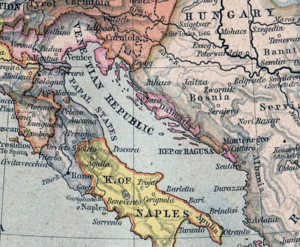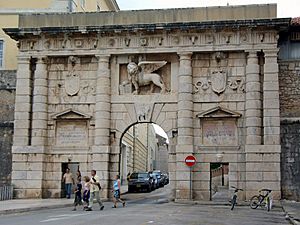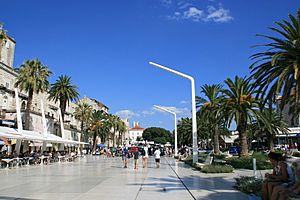Italian cultural and historic presence in Dalmatia facts for kids
The Italian cultural and historic presence in Dalmatia talks about how Italy has influenced the region of Dalmatia. Today, Dalmatia is split between Croatia, Herzegovina, and Montenegro. This influence covers both history and culture.
Contents
A Look Back: Italian Influence in Dalmatia
Ancient Roman Times
The Italian influence in Dalmatia began a long time ago. It started when the Roman Empire conquered the area. A famous historian named Theodore Mommsen said that by the 300s AD, all of Dalmatia spoke Latin. This means it was fully Romanized.
Early Middle Ages and New Settlers
Later, in the 400s and 500s, groups like the Avars and Slavs invaded. This led to different Slavic tribes, especially the Croats, settling in Dalmatia. The original Latin-speaking people moved to coastal cities and islands. Some also went to the mountains.
During this time, cities like Zara, Spalato, Ragusa, and Cattaro kept their Latin culture. They were called "Dalmatian maritime neolatin cities." They had strong connections with Italy. This was thanks to lots of trade across the Adriatic Sea.
Venetian Republic's Strong Hold

From the 10th century, the Republic of Venice became very powerful in Dalmatia. Venice slowly blended the local Latin-speaking people into its culture. However, the Slavic people living there kept their own language.
Venice controlled most of Dalmatia from 1420 to 1797. This period was called "Venetian Dalmatia." It was a time of great wealth and growth in arts and culture. The Italian Renaissance had a huge impact. Many beautiful buildings, churches, and cathedrals were built. You can still see them in cities like Zara, Spalato, Sebenik, and Ragusa.
During these centuries, the Venetian language became the main language. It was used by everyone for trade and communication. It even influenced the local Croatian language. Zara was the capital of Venetian Dalmatia. It remained an important city for centuries.
Napoleon and Austrian Rule
In 1797, Napoleon's armies defeated the Republic of Venice. Dalmatia was then briefly part of the "Napoleonic Kingdom of Italy" from 1805 to 1809. During this time, schools were opened for everyone. The Italian language became the official language in schools.
Later, Austria took control of Dalmatia. This led to a rise in the importance of the Slavic people. The number of Italian speakers in Dalmatia decreased a lot. For example, in 1816, about 22% of people spoke Italian. By 1910, this number was only about 2.9%.
After the World Wars
After World War I, Italy gained Zara and some northern islands. During World War II, Italy took over most of Dalmatia. After World War II, Italy lost all its territories in Dalmatia. More than 22,000 Dalmatian Italians moved away. This event is known as the Istrian-Dalmatian exodus.
Today, there are still some Dalmatian Italians left. About 300 live in Croatia and 500 in Montenegro. In Zara, the small Italian community was finally allowed to have a kindergarten for Italian-speaking children in 2012. This shows how much the Italian population in Dalmatia has changed over the last century.
Cultural Influence in Dalmatia
The cultural influence from Italy has been huge in Dalmatia since Roman times. It grew even stronger during the time of the Republic of Venice. The Italian Renaissance also played a big part.
Architecture and Art
Many Roman buildings and monuments can still be seen in Dalmatia. The most famous is the Palace of Diocletian in Spalato. From the 6th to the 10th century, Dalmatian architecture was influenced by Constantinople. Then, the Romanesque style came from Italy. The bell tower of S. Maria in Zara, built in 1105, is a great example.
Later, Venetian Gothic architecture became popular in the 15th century. Even in Ragusa, which was not part of Venice, you can see Venetian Gothic styles. In 1441, Giorgio Orsini from Zara brought the Italian Renaissance style. This new style was quickly copied by other architects.
Newspapers and City Planning
In the 19th century, the first Dalmatian newspaper was created in Zara. It was called Il Regio Dalmata - Kraglski Dalmatin. It was published in both Italian and Croat. This newspaper was started by an Italian, Bartolomeo Benincasa, in 1806. It was also the first newspaper printed in the Croat language.
Italian influence is also clear in how Dalmatian cities were planned. A great example is Split (Spalato). In 1880, Antonio Bajamonti, the last Italian mayor of Spalato, designed a city plan. It focused on the "Riva," a seaside walkway with palm trees. This was inspired by the Italian Riviera. Even today, the Riva is a popular place for locals to walk and enjoy cafes.
Music and Language
Italian influence was also very strong in music. The Venetian language became a common language in Dalmatia. It even influenced the local Croatian language.
Perasto: A Lasting Example
The small town of Perasto (now Perast in Montenegro) is a great example of Italian influence. Perasto was very important in the 18th century under the Republic of Venice. It had many shipyards and a large fleet of ships. The town was full of beautiful Baroque palaces and Venetian-style houses.
Perasto had a special privilege. It was allowed to keep the war flag of the Venetian Navy during peacetime. It was called "La fedelissma Gonfaloniera" (the most faithful flag bearer) descriptive text. The sailors of Perasto even fought in the last battle of the Venetian navy in 1797 more info here.
When the Republic of Venice fell in 1797, Perasto was the very last city to lower the Venetian flag. On August 22, 1797, Count Giuseppe Viscovich, the Captain of Perasto, lowered the flag. He gave a farewell speech to the crying people. He then buried the "Gonfalon of Venice" under the altar of the main church.
Today, Perasto has a smaller population. About 140 people still speak the original Venetian dialect of Perasto at home. They call themselves "Montenegrins" in the census.
Related pages
- Dalmatia
- Dalmatian Italians
- Dalmatian maritime neolatin cities
- Istrian-Dalmatian exodus
- Italian language in Croatia
- List of Italian place names in Dalmatia
- Venice and Dalmatia
- Albania veneta
- Cattaro (Italian province)
- Spalato (Italian province)
- Zara (Italian province)
- Italian irredentism in Dalmatia




